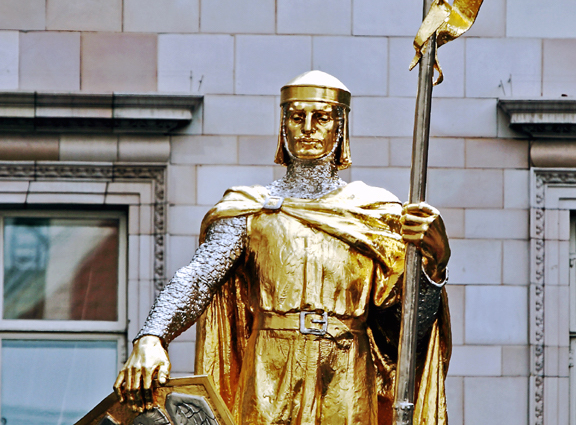Count Peter and the Savoy
Posted in hospitals, hotels, Medieval, Pre-1700, Strands and tagged with Count Peter of Savoy, hospitals, hotels, Oscar Wilde, the Savoy

This week has seen the return to the Strand of a very important figure: Count Peter of Savoy. He’s the gilded figure on the pediment entrance to the Savoy Hotel who looks like a Wagnerian extra on the run. Now resplendently restored and polished, he looks alarmingly like Darth Vader. But it’s good to see him back, after many months under wraps while the Savoy was refurbished.
Why does he matter? Because he is a link between hospitals and hospitality, both important on the Strand; he links the 21st century to the 12th. Born in 1203, he was Count of Savoy from 1263 until his death five years later. His niece was Eleanor of Provence who married Henry III of England; in 1241 Henry made Peter the Earl of Richmond and gave him land between the Thames and the Strand on which to build a palace. Savoy gave its name to cabbages too – but for the Strand, the Savoy Palace became a grand mansion of the nobility. Here Geoffrey Chaucer began the Canterbury Tales, and the aristocratic palace survived until 1381 when it was destroyed in the Peasants’ Revolt.
On the site in 1512, Henry VII founded the Savoy Hospital for the poor, which lasted till the eighteenth century, when its ruins finally foundered away. So Count Peter symbolises the Strand’s history of aristocratic palaces, and, more loosely, its nobler history of medicine for the needy. The new incarnation of one of London’s grandest hotels, with its Edwardian and Art Deco history, is as visibly rich as the palatial original. In between came the hospital that gives us also the word for hospitality – in the sixteenth century, you afford hospitality to those in an institution for the sick; kindness and care go together. Other evolutions of ‘hospital’ give us ‘hotel’, spital (as in Spitalfields) and ostler. The shininess of Count Peter has artistic pedigree – it’s very Art Deco. Behind the figure is a beam of stainless steel, invented in 1928, and the panels in the Savoy’s entrance that tell the story of the Peasant’s Revolt were put up in 1929, also in the new material. Even so, now the hoardings advertising the Savoy Theatre’s musical of Legally Blonde have come down, you might well think that Count Peter is fronting the show of Legally Bling.
One of the Savoy’s famous guests was Oscar Wilde, and the statue of Count Peter reminds me of his story of the Happy Prince. He stood in gold above the city, with two sapphires for eyes and a ruby in his sword hilt. He is visited by a swallow on his way to Africa, who becomes his messenger in salving the sufferings of the poor. As he stands above the city, the Happy Prince can see hunger, sickness, longing, and he sends the swallow with his jewels, one by one, to relieve them as best he can, asking the swallow to pull off his gold leaf until his leaden heart bursts. The swallow, too late now to fly to Africa, perishes of cold at the Prince’s feet. When the Mayor and councillors notice the statue, they declare it shabbily unfit and have it melted down. The Prince’s leaden heart and the dead swallow escape the furnace: when God asks for the most precious things in his city, angels bring him the heart and the bird. ‘There is no Mystery so great as Misery’, said the Happy Prince. Count Peter overlooks a London street: while gilded people pass below his feet, what misery might he see?



Why is that statue there at all? Surely it should have been John of Gaunt up there instead. He was the one who made the Savoy into a magnificent Palace and it was during his lifetime that it was destroyed as well. He was also related by marriage to Chaucer as Katherine Swynford who became Johns third wife was the sister of Chaucers wife. John, Duke of Lancaster is much more meaningful to English history than Peter of Savoy.
I agree, having just read Anna Seton’s book ‘Katherine’- an amazing story about John of Gaunt’s life and times at his Savoy Palace and his eventual marriage to Katherine Swynford, sister of Geoffrey Chaucer’s wife Phillipa. Too right it should be his statue up there!